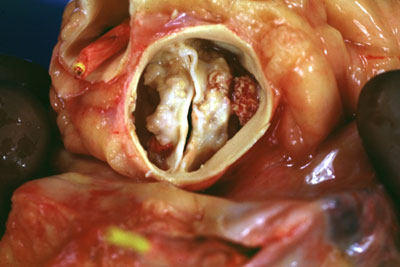Calcified Heart Valve Leaflets
As you can read in my story, I needed aortic valve replacement surgery because I suffered from severe stenosis and regurgitation. One of the key causes of my valve disease was the calcification of my heart valve leaflets. Said differently, I had calcified valve leaflets.
According to the Cleveland Clinic, "fibro-calcific degeneration" most commonly affects the aortic valve. Interestingly, calcified heart valves typically occur in adults over the age of 65. However, I was only 33 years old when I needed surgery.

The photograph above shows the aortic valve with a short segment of the aorta around it. As you can see, the valve clearly has only two cusps (a bicuspid aortic valve), instead of three, and is severely narrowed due to the calcified leaflets.
When the leaflets are calcified, the valve leaflets become fibrotic (thickened) and calcified (hardened), producing a narrowed valve opening. Risk factors for this type of valve disease include increased age, low body weight and high blood pressure.
What Does A Calcified Heart Valve Feel Like?
If you placed your fingertip through the opening, the valve would feel hard and gritty.
A doctor may suspect aortic valve sclerosis on hearing a heart murmur with a stethoscope. However, an ultrasound of the heart (echocardiogram) can distinguish between aortic valve sclerosis and stenosis and check for other possible causes of a heart murmur.
Calcified valve leaflets can also impact each of the other valves within the heart - the aortic valve, the mitral valve, the tricuspid valve and the pulmonary valve.
My Story With Calcified Heart Valve Leaflets?
Two weeks after my aortic valve replacment surgery, I met with my surgeon, Dr. Vaughn Starnes at USC Medical Center. Doctor Starnes told me that my aortic valve was in "very, very bad shape" and that "it was very good timing" for the operation." Dr. Starnes also emphasized that my bicuspid aortic valve leaflets were "very calcified, very white" and impacting the flow of blood through my heart and body.
It's a good thing that I had my aortic valve replaced when I did. My left ventricle had already started to dilate and I was starting to experience symptoms.
Now, 13 years after my Ross Procedure, I've gone on to live a wonderful life. I've gotten married. I had a child. And, I've never looked back.
Plus, I no longer have any calcium on my heart valve replacement!
You May Also Like
To help you learn more about heart valve disease and treatment options, you may like:
- Surgeon Q&A: 8 Important Facts About Calcified Heart Valves
- Aortic Valve Replacement: What Should Patients Know?
- Surgeon Q&A Video: Heart Valve Replacement Options with Dr. Trento
- Aortic Stenosis Progression: Top 5 Facts Patients Should Know
- Research Leading Hospitals that Specialize in Heart Valve Disease
- Meet Heart Valve Patients in Our Community
Page last updated: September 18, 2020



